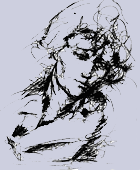
Jori's images are real sacred images. You can create graceful and charming images, made with the greatest craftmanship, delight for art amateurs, ornament for churches and halls, beautiful but not sacred images.
The monumental high-riliefs of the artist are sacred images because they are images from the soul, images of inner life. Jori lets his soul speak through clay: it tells us about the deep contrasts of life; about the primary play of Light, of Shadows; it tells us how Love can subdue the differences into a Superior Unity. Jori's images are real images because they show us the Invisible through concrete things. The poetic value of the artist's work lies in his ability to give visual expression to abstract concepts which, therefore, leave the realm of imagination to become familiar and comprehensible. Jori's creatures combine the light and glamour of Life with the darkness and silence of the Unimaginable. Jori's style is therefore imaginative, visionary. It's Poetry in pursuit of Truth (Aletheia). The poet (poiesis = to create) creates Truth. The poet's poiesis expresses the primary Truth, embodies a new cosmic vision. Art, as vision, doesn't demonstrate but just hints. The world is no longer real, reality achieves a symbolic value. Symbolism is the only possible expression of some otherwise inexpressible spiritual essence. Poetry is the only fitting speech for some mistery of disembodied life, it's the restored sympathy between the man and the One who creates him. Jori's creative mind is once again eloquent in three works of art created just to pay homage to Leon Battista Alberti: "The hermetic man", "The Albertian will" and "The hermetic woman"; two square panels of 2.5 meters side and a rectangular panel. The monumental high relief shapes of applied clay transmit by their gouged and fringed material, the cosmos feeling and its no-return chasm.

